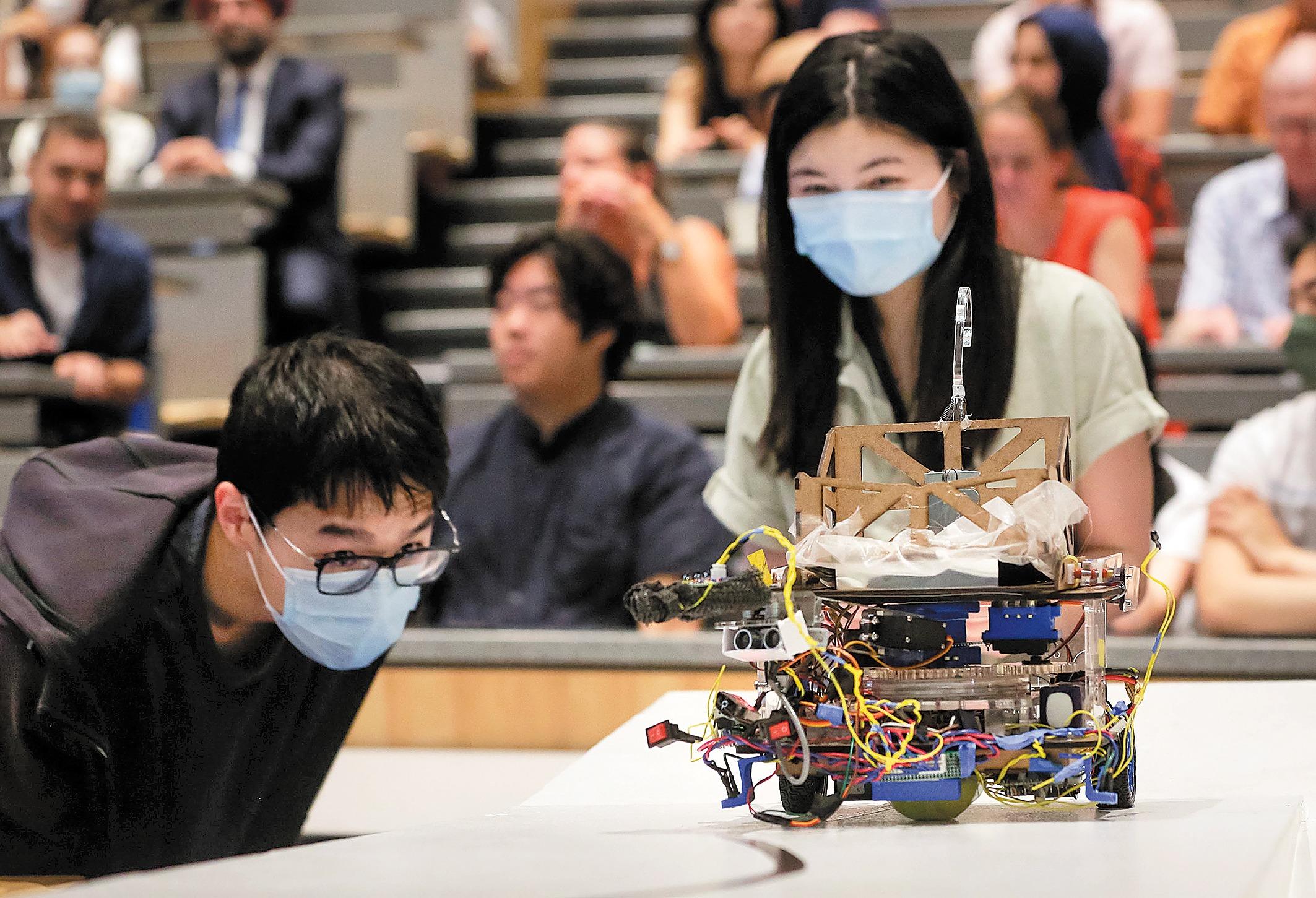Anti-Asian racism, safety fears and better opportunities nearer home amid reasons for death of American Dream
 International students arrive at Kwansei Gakuin University in Nishinomiyia, Japan, in September. (PHOTO /THE YOMIURI SHIMBU)
International students arrive at Kwansei Gakuin University in Nishinomiyia, Japan, in September. (PHOTO /THE YOMIURI SHIMBU)
He Yijing, a sophomore student, was sitting in a campus hallway at Zhejiang University of Finance and Economics in Hangzhou, capital of Zhejiang province, on Nov 9, 2021, when she learned that a 24-year-old Chinese graduate student at the University of Chicago had been fatally shot.
Studying English for her upcoming Graduate Record Examination, a standard requirement for entry to graduate schools in the United States, He said she was deeply shocked by the death of Zheng Shaoxiong, who was killed during a robbery near his university campus.
Zheng was studying statistics in Chicago, which was also He’s field at the time. “I was so sorry to hear about his death,” said He, who later became one of many Chinese international students who changed their plans to study in the US.
Last year, some 290,000 Chinese students were studying in the US, an 8.6 percent decline from the previous year, data from the Institute of International Education, or IIE, show. In contrast, the number of Indian students in the US stood at about 200,000 last year, a 19 percent rise compared with the previous year.
The allure of the American Dream appears to be fading for many Chinese students.
 Chinese students at Moscow State University perform a dance during Spring Festival in February. Many Chinese students have chosen destinations other than the US for their overseas studies. (PHOTO / CHINA NEWS SERVICE)
Chinese students at Moscow State University perform a dance during Spring Festival in February. Many Chinese students have chosen destinations other than the US for their overseas studies. (PHOTO / CHINA NEWS SERVICE)
In 2015, some 51 percent of Chinese students expressed a desire to study in the US, but by last year, the proportion had fallen to 30 percent, surveys by Chinese education company New Oriental Education & Technology Group show, along with data gathered by The Wall Street Journal.
Increasing gun violence is one of the reasons international students, including those from China, are choosing not to study in the US.
In 2018, an IIE survey found that about 44 percent of international applicants for the 2017-18 academic year said they were primarily concerned about their safety when deciding whether to study in the US. They were particularly worried about gun violence and civil unrest.
“With news of shootings every day, I find it really frightening,” said He, who chose to study in Hong Kong.
Data show that the decline in international student enrollment could affect US universities and the economy. International students often pay higher tuition fees, making many US institutions reliant on these revenue streams.
CNN quoted NAFSA, or the Association of International Educators — an international alliance of professional educators — as saying the decline in international student enrollment has resulted in an estimated loss of $11.8 billion to the US economy, along with more than 65,000 jobs.
 Students compete in a robot design contest at the University of British Columbia in Vancouver, Canada, in August. (PHOTO / XINHUA)
Students compete in a robot design contest at the University of British Columbia in Vancouver, Canada, in August. (PHOTO / XINHUA)
China has been the top country of origin for international students for more than a decade, with some 31 percent of such students in the US coming from China, the IIE said.
In 2018 alone, Chinese students brought in $14.9 billion, primarily through tuition fees and living expenses, the US Department of Commerce reported.
Data also show a decline in the number of international students studying sciences, particularly those from China, which affects the US in terms of attracting high-tech talent.
Around half of the 1 million international students in the US are enrolled in STEM programs — science, technology, engineering, and mathematics — which typically bring highly skilled labor to the US job market.
Established job opportunities for STEM students after graduation made the US an ideal country to study in, He said.
However, it is increasingly challenging for Chinese students and scholars, particularly those studying STEM fields, to remain in the US.
A 2020 ban implemented by former US president Donald Trump restricted the entry of graduate students from certain Chinese universities believed to have connections with the Chinese military. Many of them are STEM students, and the ban is still in effect under the Biden administration.
 Staff members promote Canadian universities and colleges at an education fair in Beijing in February. (WANG ZHUANGFEI / CHINA DAILY)
Staff members promote Canadian universities and colleges at an education fair in Beijing in February. (WANG ZHUANGFEI / CHINA DAILY)
Last year, the US Justice Department ended its China Initiative, following calls by academic and civil rights groups. The initiative was criticized for impeding academic collaboration and contributing to anti-Asian bias.
The Organisation for Economic Cooperation and Development, or OECD, an intergovernmental grouping comprising 38 member countries, said new data show that the US is losing the competition for scientific talent to China and other nations.
In 2021, the US lost published research scientists to other countries, while China gained more than 2,400 scientific authors, data published in April by the OECD revealed. This marks a reversal from as recently as 2017, when the US gained 4,292 scientists, while China attracted only 116.
As a student in the field of data science and computer science, He said China’s economic development in recent years made her realize there are more opportunities at home, and that staying in China for her professional growth is a viable option.
Meanwhile, rising anti-Asian racism and the deterioration of China-US relations are prompting Chinese students to seek higher education elsewhere.
In Florida, the University of Miami Herbert Business School saw a 30 percent drop in Chinese graduate students last year. The school is ranked No 1 in that state and 26th globally for business administration based on the 2021 World University Rankings.
John Quelch, dean of the business school, said last year that Chinese students had dropped to 140 from a peak of about 300 four years ago.
“I feel that the cumulative weight of deteriorating US-China relations has definitely caused more parents and potential students in China to question whether the US is a hospitable place,” Quelch said.
 Malaysian higher education institutions promote their programs at a fair in Beijing in April. (DU JIANPO / FOR CHINA DAILY)
Malaysian higher education institutions promote their programs at a fair in Beijing in April. (DU JIANPO / FOR CHINA DAILY)
State laws in Florida limit relationships between its academic institutions and those overseas, specifically China, as well as seeking funding overseas. A recent bill in Ohio follows suit, while Texas has sought to ban overseas Chinese students entirely.
The COVID-19 pandemic not only significantly reduced enrollment rates among Chinese international students in the past year but has had a lasting impact.
A report last year by The Wall Street Journal said that during the first half of 2022, the number of US student visas issued to Chinese nationals fell by more than 50 percent compared with pre-pandemic levels.
However, the recruitment of Chinese students had been faltering in the three academic years before the pandemic emerged. For example, IIE data show that while the 2012-13 academic year saw a more than 21 percent rise in Chinese students, the uptick in 2019-20 was less than 1 percent.
Some Chinese students were reluctant to travel far from home during the pandemic with Asian destinations such as Hong Kong and Singapore emerging as popular study choices.
A study last year by New Oriental, a comprehensive education and training institution, found that interest among Chinese students in studying in the US had been declining since 2017, even as overall interest in studying abroad surged.
More students are now expressing an interest in going to the United Kingdom while interest in Hong Kong and Singapore is climbing steadily, the report said.
 Visitors to an expo in Beijing are attracted to the booths of Hong Kong educational institutions. (DU JIANPO / FOR CHINA DAILY)
Visitors to an expo in Beijing are attracted to the booths of Hong Kong educational institutions. (DU JIANPO / FOR CHINA DAILY)
In 2015, about 8 percent of students from the Chinese mainland expressed a desire to study in Hong Kong but by last year, the proportion had risen to 19 percent, while interest in studying in Singapore rose from 6 percent to 14 percent over the same period, the report said.
Canada has seen a rise in the number of Chinese students studying in the country.
Data from Axios show that Chinese student enrollment at the University of Toronto has risen annually for the past decade. Some 15,700 Chinese students were studying at this institution for the 2022-23 academic year, up from about 6,000 in 2013-14.
In 2021-22, the UK saw the highest influx of Chinese students — more than 150,000 — compared with any other country. This marked a rise of 41 percent, or 44,475 students, from 2017-18 to 2021-22, data from the UK’s Higher Education Statistics Agency show.
Now 23, He is studying data science and analytics at The Hong Kong Polytechnic University and is preparing to start her second master’s program in computer science at The University of Hong Kong in the autumn.
She said she would choose Hong Kong over the US for her studies again if given the opportunity.


